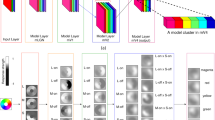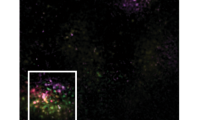Abstract
One of the remarkable features of vision is that the perceived colour of reflecting surfaces which form part of complex, multicoloured scenes, remains stable despite large variations in the spectral composition of the illuminating light1–5. The phenomenon of colour constancy has long been known but only recently have electrophysiological studies revealed a possible mechanism for it in an area of visual cortex, the V4 complex in the rhesus monkey. Lesions in the V4 complex of experimental animals6,7 have produced little if any impairment of wavelength discrimination, but colour constancy has not been tested. In the present study we used a broader range of behavioural tasks, including one of colour constancy, to test the prediction that ablation of the V4 complex leads to selective deficits in colour perception. The results support the notion that the V4 complex is necessary for colour constancy but not for the discrimination of hue.
Similar content being viewed by others
References
Young, T. in Lectures in Natural Philosophy Vol. 2 (J. Johnson, London, 1807).
Hering, E. Outlines of a Theory of the Light Sense (transl.) (Harvard Univ., Cambridge, Massachusetts, 1964).
Land, E. Proc. natn. Acad. Sci. U.S.A. 45, 115–129 (1959).
Jameson, D. & Hurvich, L. M. J. opt. Soc. Am. 49, 890–898 (1959).
Land, E. Proc. natn. Acad. Sci. U.S.A. 80, 5163–5169 (1983).
Dean, P. Expl Brain Res. 35, 69–83 (1979).
Fries, W. & Zeki, S. Proc. EBBS Workshop. Animal and Human Psychophysics, 226 (1980).
Zeki, S. Nature 284, 412–418 (1980).
Zeki, S. J. Physiol., Lond. 277, 273–290 (1978).
Zeki, S. Neuroscience 9, 741–764 (1983).
Zeki, S. Brain Res. 34, 19–35 (1971).
Zeki, S. J. Physiol., Lond. 277, 227–244 (1978).
Livingstone, M. S. & Hubel, D. H. J. Neurosci. 4, 309–356 (1984).
Gouras, P. J. Physiol., Lond. 238, 583–602 (1974).
Michael, C. J. Neurophysiol. 41, 1223–1248 (1978).
Hubel, D. H. & Wiesel, T. N. Proc. R. Soc. B198, 1–59 (1974).
Meadows, J. B. Brain 97, 615–632 (1974).
Damasio, A., Yamada, T., Damasio, H., Corbett, J. & McKee, J. J. Neurol. 30, 1064–1071 (1980).
Pearlman, A. L., Birch, J. & Meadows, J. C. Ann. Neurol. 5, 253–261 (1979).
Scotti, B. & Spinner, H. J. Neurol. Neurosurg. Psychiat. 33, 22–28 (1970).
Varney, N. R. J. Neurol. Neurosurg. Psychiat. 45, 240–252 (1982).
Owen, M. J. & Butler, S. R. Behav. Brain Res. 3, 115–123 (1981).
Land, E. Proc. R. Instn Gt Br. 47, 23–57 (1974).
De Valois, R. L., Morgan, H. C., Polson, M. C., Mead, W. R. & Hull, E. M. Vision Res. 14, 53–67 (1974).
Munsell Book of Colour (Munsell Colour Co., Baltimore, 1976).
Author information
Authors and Affiliations
Rights and permissions
About this article
Cite this article
Wild, H., Butler, S., Carden, D. et al. Primate cortical area V4 important for colour constancy but not wavelength discrimination. Nature 313, 133–135 (1985). https://doi.org/10.1038/313133a0
Received:
Accepted:
Issue Date:
DOI: https://doi.org/10.1038/313133a0
- Springer Nature Limited
This article is cited by
-
Loss of attentional stimulus selection after extrastriate cortical lesions in macaques
Nature Neuroscience (1999)
-
The visual system and levels of perception: Properties of neuromental organization
Theoretical Medicine (1993)





